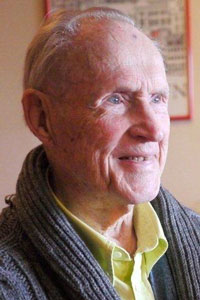
Tribute to John Gooch
"Jack" Troster W2ISQ, W6ISQ
November 10, 1920 - January 11, 2014

John "Jack" Troster
became a Silent Key (SK) on January 11th. He was 93 years old.
His wife of 65 years, Marguerite KC6NFE, was at his bedside when
he passed. Jack along with Vince Chinn K6KQN (now W6EE), Lee
Shaklee W6BH (SK), and Don Schliesser K6RV, was one of the
founding members of the Northern California DX Foundation (NCDXF)
in October 1972. He also served on the NCDXF Board for 26 years
as well as NCDXF's third President from 1975 - 1986.
Jack was a U.S. Marine officer.
W6ISQ, writes the following about W2ISQ, Yonkers, New York, in 1938 . . .
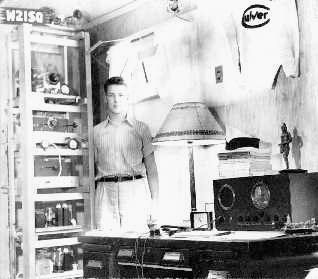
Rig is 676 - 807 - 35T - 250TH, running 450 watts, feeding a 66-foot end-fed zepp up about 30 feet. I used them beautifoool 866 mercury vapor rectifiers that glowed blue in the dark. I also hung a neon bulb on the zepp feeders to help tune up. On summer nights, I would turn off the room lights and key the rig. Strollers would stop outside the house and wonder about the blue and neon flashes.
The receivers were a Super Skyrider and RCA-ACR-136. I still have the Vibroplex and the final tank condenser, which I use as an antenna tuner. The rig in the photo replaced a classic 47 - 46 - pr 46s. And before that was a huge variety of different kinds of oscillators and low-powered finals -- including the great 210 TNT with a nice ripe T4. - Note: I built about one rig a month by sawing off another 17 inches from a long board I kept in the basement.
In the fall of 1935 I worked my first DX with a few watts from the TNT. That was a station in Montreal, followed soon by a contact with Cuba. I was captivated and have been chasing DX ever since. I also got into Sweepstakes and DX contesting. Traffic handling was also great fun, but I've been chasing DX and contesting almost continuously ever since. See you in the pileups!
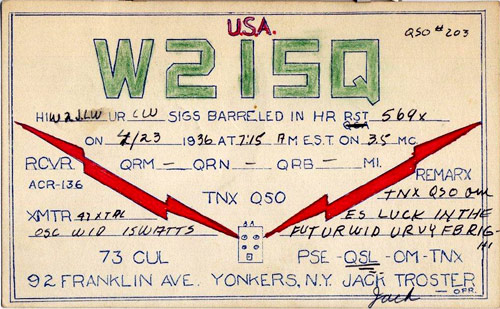
W2ISQ Jack Troster 1936 Yonkers, NY
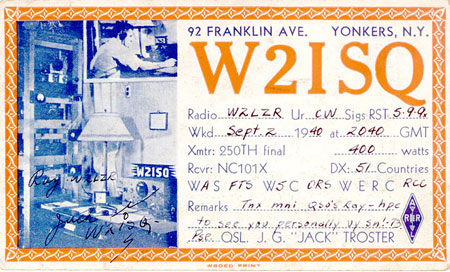
W2ISQ Jack Troster 1940 Yonkers, NY
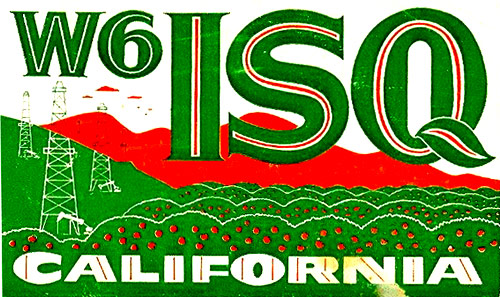
Here is a QSL from the 1975 CR9AK DXpedition to Macau that Jack was on:
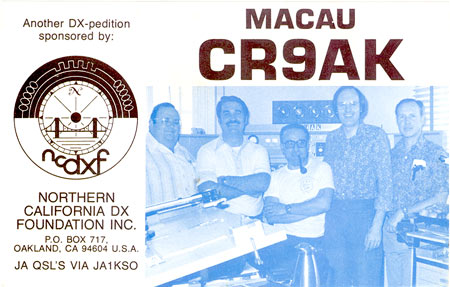

CR9AK 1975 Macao
Operators: VS6DR, K6AHV, CR9AK, W6MAV, W6ISQ

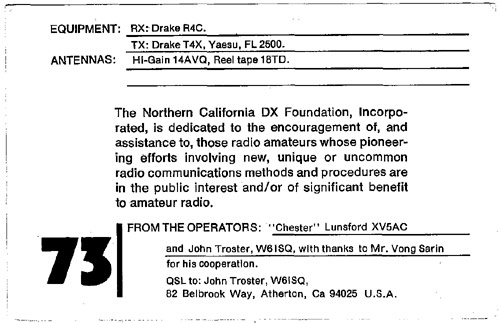
Jack Troster W6ISQ and Chester Lunsford XV5AC activated XU1AA from the Khmer Republic in 1973. This was the first DXpedition ever sponsored by NCDXF.
Autumn 1998 - Northern California DX Foundation Newsletter
AN
INTERVIEW WITH JACK
TROSTER, W6ISQ
by Rusty Epps, W60AT
At NCDXF's July '98 meeting, Jack Troster, W6ISQ announced his decision to retire from NCDXF's Board of Directors and to pass his duties as Beacon Project Coordinator on to Bob Fabry, N6EK. Jack's announcement brought to a close his 26 year formal association with the Foundation. With Jack's departure from the Board goes the last of NCDXF's original founders. Although Jack assures us he's still only a telephone call away, those of us remaining on the Board will sorely miss his steady guidance, keen insight, wealth of knowledge, and quick wit. I recently caught up with this amazing, wonderful man over lunch and had a chance to talk with him about his life and NCDXF.
OAT: So, Jack, how did it all start?
ISQ: It was back in the early 30's when I was living in Yonkers New York. One day the kid next door showed me a crystal set he had built. I thought it was pretty neat, so I decided to see if I could build one too. With my set, I was able to hear two broadcast stations in New York City. Unfortunately, I had to listen to both of them at the same time because my set had no selectivity! Still though, that was enough to get me hooked. Soon thereafter, I got interested in short wave radio and in September, 1935 at age 14, received my license and the callsign W2ISQ.
OAT: Were you on the air a lot back then?
ISQ: Yes. While I was in high school I often got up at three or four o'clock in the morning to work 80 meters. That's when I made my first DX QSO - with a VE2 in Montreal. It was only about 200 miles away, but I was so excited to have worked a "foreign" station. I also did a lot of traffic handling on 40 meters. I left for Dartmouth College a couple of years later and that limited my radio time significantly. Not too long after that, the war came along and everybody got put off the air. I joined the marines and was sent to the island of Emirau in the western Pacific, and after the war ended, I got reassigned to Hollywood, California to work with the Armed Forces Radio Service. During all those years I never lost my interest in amateur radio, though, and looked forward to the time when I could return to the airwaves. I even went so far as to see if the call W6ISQ might be available. Unfortunately, it had already been issued to some guy in Arizona. When I learned that Arizona was going to become part of W7 rather than W6, I sat down and wrote a letter to the FCC asking if I could have W6ISQ. Sure enough, they issued me that callsign less than a month later. I've had it ever since. In the early 80's the FCC let us apply for 2-letter calls and I got N6IQ, but when the FCC later said we could keep only one callsign, I decided to stick with the "Italian String Quartets."
OAT: How did you get up here to Northern California?
ISQ: Well, that goes back to 1946. The war was over and I decided it was time to do two things. The first was to marry the most wonderful lady in the world (Marguerite, KC6NFE, Jack's wife of 52 years), and the second was to go back to graduate school. I enrolled at Stanford University in Palo Alto, California and decided to study geology because that seemed to be the only one of my interests at which I thought I actually might be able to make a living and support my family.
OAT: What about amateur radio in those days?
ISQ: Yes, I also decided it was time to get back on the air. I had all my radio equipment packed away, so I shipped it up to Palo Alto when I went to Stanford. I first set up the station in our one room student apartment but that proved too crowded. Later I moved everything to a lab building on campus used by the Stanford Radio Club and did most of my operating from there. For the first few years after I graduated I still didn't have room for a station at home, so I just left the equipment at Stanford and it got used by a number of other fellows who followed behind me. It was probably another five year beore I finally was able to move the station to my house and begin some serious DXing.
OAT: You have some pretty impressive operating achievements, don’t you?
ISQ: Well, I’ve certainly had a lot of fun over the years. [In Jack’s characteristicly modest fashion he tried to evade my question. I persisted. Only after much prodding did he finally acknowledge that he holds DXCC #1 Honor Roll on the Mixed CW and SSB modes; 5B-DXCC; 5B-WAS (certificate #4); USA Counties Award (for working all 3,076 USA counties, which he did completely on cw !). Jack is a member of FOC and the Al Operators Club; he has served as president of both the Northern California DX Club and the Northern California Contest Club; he is a Contributing Editor of QST magazine; he has been a director of the Quarter Century Wireless Association and for years wrote the monthly QCWA column published in World Radio News. He currently serves as the Pacific Division's representative on the ARRL DX Advisory Committee. He has been named NCDXC's DXer of the Year, and in 1988 Jack was inducted as the 27th member of the CQ DX Hall of Fame.]
OAT: Wow!!
OAT: What about NCDXF?
ISQ: Well, that goes back to October, 1972. In those days, Vince Chinn, K6KQN (now W6EE) had worked for the Internal Revenue Service. Vince knew IRS regulations permitted US taxpayers to make tax-deductible donations to certain types of educational and scientific organizations. Vince realized that if hams had such an organization we could raise funds to support DX related activities a lot easier. Vince invited Lee Shaklee W6BH, Don Schliesser K6RV, and me to his home in the heart of San Francisco's Chinatown and spent the evening explaining tax law to the three of us. Vince's explanation made a lot of sense, so before the night was over we agreed to form the NCDXF. Out came the checkbooks and wallets and that night the Foundation collected a total of $1,111 for its first donations.
OAT: If I recall correctly, W6BH became NCDXF's first president?
ISQ: Yes. That night at Vince's house after we decided to form NCDXF we realized we also had to have some officers, so we turned to Lee and asked "Why don't you be president?" and he agreed. Unfortunately, Lee was able to serve only a few months before he decided to step down for business reasons. After that, Don K6RV became NCDXF's second president.
OAT: And after Don, you became NCDXF's third president?
ISQ: That's right. I served as president from 1975 until 1986. I was followed by K6AHV (now W6RJ), W60AT, W6DU and NCDXF's current president, K6ANP.
OAT: For years you have led NCDXF' s worldwide beacon project. Tell us about this network. Didn't you play a major role in its creation?
ISQ: Well, I and a lot of other folks. Remember how Vince, K6KQN had explained to us on that first night that NCDXF would need educational or scientific purposes to justify its tax status? Well, I began looking for projects which would meet the IRS's requirements and also be useful to amateur radio operators worldwide. One day I was talking with NCDXF Advisor Mike Villard, W6QYT who was an Electrical Engineering professor at Stanford. Mike told me about an experimental radio beacon being developed for commercial purposes. The prototype version of this beacon was on the air from a labratory somewhere near Washington, D.C., and one of the unique things about it was that it cycled between transmitting first at 25 watts then at only 1 watt. I thought this was interesting so I called a bunch of my ham buddies on the telephone and asked them to listen for that beacon. Not only were we able to hear the 25 watt signal, but we also were able to copy the 1 watt signal. That's what got us thinking about using a power stepping beacon as a means of testing propagation to various parts of the world. The next stage in the beacon evolution came in July, 1974 during the Foundation-supported KP6KR DXpedition to Kingman Reef. Since the DXpeditioners were going to spend almost a week sailing between Hawaii and the reef, we made them a small transmitter which they could manually switch between power levels of five, two and one-half, and one watt. We asked hams to listen for their signal. To our amazement, we were flooded with SWL reports from people who copied them at all three power levels. In light of the huge success of the KP6KR/mm experiment, we decided to build the first of our fixed-site, power stepping beacons. That transmitter was located at Stanford University and licensed as WB6ZNL. It came on the air full time in 1979. WB6ZNL transmitted for one full minute, first at 100 watts, then 10 watts, then 1 watt, then 100 milliwatts, and finally back up to 100 watts for station ID and sign off. WB6ZNL was the forerunner of W6WX, the present Stanford beacon, and between the two of them they have been on the air almost continuously for nearly 20 years. During this time, NCDXF has received thousands of SWL reports from all around the world. For years Al Lotze, W6RQ meticulously maintained a log of these reception reports and Al's data has been used as source material for several academic studies on HF radio propagation.
OAT: How did the NCDXF come to collaborate with the IARU on the beacon project?
ISQ: Well, that was the obvious next step in the evolution of the beacon network. By the mid-1980's NCDXF had beacons operating as 4U1UN in New York City, as W6WX at Stanford, and as KH60 in Hawaii. We also had enlisted the assistance of friends like Martti OH2BH, Kan JA1BK and Bruno AA6AD to help us get beacons into Finland, the Madeira Islands, Japan and Israel. But if we really were going to get beacons located at strategic sites all around the globe, we needed the assistance and contacts of an international organization. The IARU was right there to help when we needed them. Thanks to the wonderful support from the IARU (and particularly from IARU president Dick Baldwin, W1RU), we now expect to expand the network to 23 fixed-site, multi-band, power-stepping beacons. The 24th and final beacon in the network will be a "roving" beacon. It will be carried on NCDXF supported DXpeditions and hopefully will give the world's DXers a tool by which they can figure out how best to work the rare DX location.
OAT: Now that you've retired from NCDXF's board of directors and entrusted leadership of the beacon project to N6EK, what will you do with all your free time?
ISQ: That's easy! I'm going to get back on the air and work DX. I finally got my station together, a Kenwood TS-850 transceiver, Alpha 76A amplifier, and Force 12 monoband antennas. I can hardly wait to wade into the pileups.
OAT: Just remember to tell all those rare DX stations to listen for your NCDXF buddies.
ISQ: QSL, OM!!
Not many will recall but Jack was involved heavily in the MARAC Awards program. He had worked ALL Counties USA which then amounted to 3077 including Alaska and Hawaii. I recall his dots and dashes on the CW lanes chasing new counties, USA-CA. It is a good diversion and keeps the filaments glowing. W8SU
W6ISQ Photo by N6TV
CR9AK QSL courtesy of VK4TL
1936 W2ISQ QSL from the estate of W2JXN, W2JLW, W6ZNO
1940 W2ISQ QSL from the estate of W3MCZ / WA3HAN / W8FE / W2LZR /
W3UT
W6ISQ QSL courtesy of W8SU
1938 W2ISQ Hamshack Photo & Info courtesy of QCWA.org
W6ISQ Interview & XU1AA QSL courtesy of W6OAT
Interview used with permission from W6OAT & NCDXF
Special thanks to KK8W, W8SU, W6OAT for all the help
Some info courtesy of W5KNE